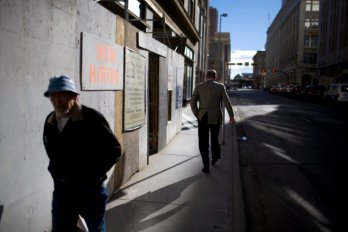huaraz — On May 31, 1970, Huaraz, the capital of Peru’s poor, mountainous Ancash province, was levelled by an earthquake that registered 7.75 on the Richter scale. Many title deeds were lost in the disaster, and in the rebuilding effort most properties were up for grabs. A lot of native old-money Huaracinos didn’t bother rebuilding and relocated to Lima or other parts of the country. Into this vacuum came people from the mainly indigenous communities around Huaraz. Anyone who could muster the resources to build a basic house then leveraged their ownership to obtain government-issued land titles. Much of the original post-colonial city was destroyed, but its grand Plaza de Armas survived.
Today Huaraz is a city of potholed streets lined with drab buildings, many of them erected gradually, one storey at a time. Owners add more rooms or levels when they can afford to, so many top floors sprout tufts of rusty, bent rebar, reaching up into the sky as if praying for another wave of prosperity to wrap them in cement. But while the city isn’t much to look at, it is growing rapidly, buoyed by the mining industry and tourism — every year, thousands of hikers and climbers are drawn here by the surrounding Cordillera Blanca mountains. Like many cities in South America, Huaraz is also home to an expanding middle class and its trappings: exclusive clubs, suvs, and self-serving government spending. The municipal authorities are busy beautifying the already impressive Plaza de Armas, yet a kilometre away children play on unpaved streets, and residents have to throw their trash into mountain streams for lack of decent waste-disposal programs. Less than forty years after the city was rebuilt, the gap between rich and poor is painfully obvious. And when I worked for a summer in Huaraz, it was also clear that many of Peru’s newly prospering citizens have little sympathy for the rural underclass they left behind.
It was last year, in mid-July, when a nationwide strike was paralyzing Peru. An ongoing teacher’s strike had overlapped with protests against land reform and a free trade agreement with the United States. But there was something else at stake. The middle-class population of Peru’s cities is growing so quickly that the traditional divide between an elite of haves and a majority of have-nots (half the population lives on less than a dollar a day) is fading; a gulf between a lower-middle, urban class and a poor, rural one is taking its place. The paro (Spanish for “stop”), a mass protest during which the entire country literally grinds to a halt, is a way for Peru’s disenfranchised social groups to make themselves heard with a loud, if not necessarily cohesive, voice.
I was on my bike, running late to meet friends at a café in Huaraz, when I ran into a protesters’ roadblock. The street was deserted save for a group of men in dirty jeans, knock-off T-shirts, and traditional wide-brimmed hats. They were building a crude barricade out of chunks of broken pavement, stopping to drink beer out of tall bottles or glare at me as I considered how to proceed. The biting Andean sun was directly overhead, and I was nervous. A taxi rolled up beside me. Inside were a well-dressed father and mother with babies in their laps. They looked nervous, too. Then the driver accelerated, aiming his car at a gap in the rocks as a hail of bricks bounced off the car. The men laughed as the taxi sped off, and I took advantage of their distraction to dodge through.
Pedalling as fast as I could, I reached the café, which, like most other businesses, was officially closed. But Tim, the owner and an ngo consultant, let me in and invited me up to the roof, where I watched the protesters stream by. Most of them were Quechua farmers, waving anti-government banners, with the motto of Latin American protest on every one of thousands of sets of lips: El pueblo unido jamás será vencido! Every now and then, they hurled bricks at buildings or cursed at the riot police standing in formation along the streets.
“This is how they can show the city people that they still exist,” said Tim. “This happens about every two weeks now.”
After the protesters dispersed for the night, some fellow expats and I headed to a popular bar owned by a local, Javier. After a few beers, I asked him why the paro was called.
“It’s always something different,” he said dismissively. “This is their chance to come to town, make trouble, and get away with it.” Simply by virtue of owning a business, he had become detached from the movement.
The next day, radio reports told of chaos throughout the country: trains carrying tourists to Machu Picchu were pelted with debris; in Puno, bloody street battles raged; and in Lima scores of union leaders had been arrested. But in Huaraz, the paro ended without a major incident. By Saturday morning, the city was back to business as usual. The main avenue was once again clogged with traffic, shoppers, and European backpackers. Construction crews were back at work on the Plaza de Armas. The middle class had taken back the streets. The only reminders of the “united people” were the remnants of their barricades, some smashed windows, and a few women who had stayed behind. Sitting on colourful alpaca wool blankets in front of cellphone boutiques, they hawked T-shirts emblazoned with the ubiquitous black and white features of Che Guevara.






